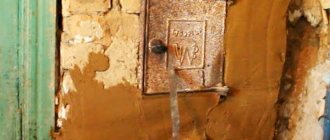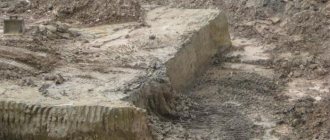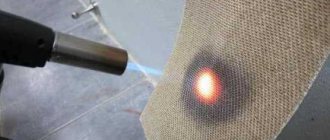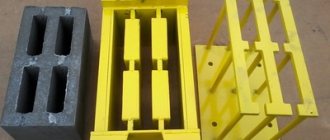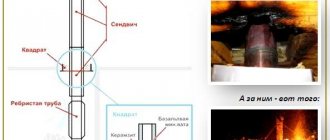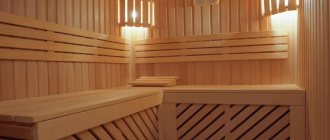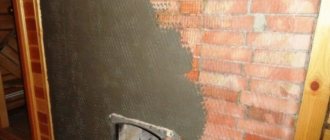Clay is a natural material formed through natural gravity; its characteristics depend on the components included in its composition. For the construction of objects that are operated under the influence of strong heat and open flame, a special type of this material is chosen. Fireclay is also called fireclay. To produce it, zircon or corundum silicate or alumina are used. The raw materials are placed in a drum or oven and fired at a temperature of +1500 degrees C. This way, water and impurities are evaporated, and the material is sintered into crumbs, the diameter of which varies from 0.5 to 2.5 mm. This technology creates high heat-resistant and fire-resistant qualities of fireclay.
Important! There are several types of fireclay. The quality of a particular material depends on the raw materials, firing technology, and additives. Some types of fireclay are used for the production of bricks, others are used to prepare plaster solutions for heating appliances, and others are used for sculpting and casting sculptures and dishes.
Advantages of refractory
Heat-resistant, fire-resistant fireclay clay has been known to man for several thousand years. Since then, its scope has changed little. Among other natural materials with the same properties, this refractory was chosen due to the following advantages:
- coatings and products made from it do not collapse, do not crack, retain their original shape, and are characterized by a long service life;
- environmentally friendly natural sedimentary rock does not harm human health and the environment;
- clay has high adhesive qualities, it adheres perfectly to metal, stone, brick and other surfaces;
- products and coatings are able to withstand heat stably and for a long time;
- the material is vapor permeable.
Varieties
Mining locations
Clay is ubiquitous, this is natural, since it belongs to sedimentary rocks, and is, in fact, rocks crushed to a powdery state.
Mining sites are often located along the banks of water bodies. Outcrops are numerous, but not all deposits are suitable for industrial production.
Where is clay mined in Russia? The most famous deposits are Kyshtymskoye, Astafievskoye, Palevskoye. It is worth noting that refractory and kaolin clays are much less common. Often, refractory varieties are adjacent to fire-resistant types.
Kyshtym clay deposit
Currently, clay is mined by quarrying. Clay pits can be of varying depths. Often different types of clays can be produced in one quarry.
Clay mining sites are divided into groups according to the degree of complexity of their development:
- Compacted clay, saturated with moisture – II;
- Lumpy, with an admixture of gravel – III;
- Hardened shale – IV;
- Loam – II;
- Frozen clay soil – IV;
- Soil with plant residues – I.
Disadvantages of refractory
Like any material, refractory clay has not only advantages, but also disadvantages:
- the material has a high price;
- The preparation of the solution is carried out strictly according to technology.
On a note! In large chain construction stores, such as Leroy Merlin or Your House, you can purchase fireclay clay at a more affordable price. There it is usually sold in 20 kg bags. The second option to save on the purchase of raw materials is to contact the sales department of the building material manufacturer itself. Also, the cost will be significantly lower when purchasing a large batch in bulk.
Quarrying methods
Development methods are different, they depend on the number of rock deposits and their location. Methods for obtaining clay:
- The most common method of extracting clay is based on excavating the fossil using hobbing excavators;
- Disruptive technologies are used for large deposits;
- Kaolin and blue clay are mined using hydromonitors. This is especially true when the layer humidity is high;
- For ceramics production enterprises, production is carried out in quarries with subsequent transportation by road or rail.
As a rule, layers contain more than one type of clay. Each type is produced separately.
Composition of fireclay refractory
In stores, fireclay is sold as a dry mixture in bags. It is produced from raw materials with a high content of highly dispersed hydroaluminosilicates. In addition to these components, refractory clay contains:
- Na sodium;
- Ca calcium oxides;
- K potassium;
- Fe iron;
- Mg magnesium;
- aluminum oxides and other components depending on the type of raw material.
When purchasing, you need to pay attention not only to the composition, but also to the expiration date. Kaolin, which is part of the building material, loses its properties over time. Expired goods cannot be used.
Attention! When choosing refractory clay for work, pay attention to mortar. This is a combination of numbers in the marking. The higher the values, the more pronounced the fireproof qualities of the materials are. Other symbols and letters may vary. As a rule, the instructions on the packaging indicate the scope of application, down to the type of bricks that can be laid.
The composition and instructions for use are printed on the packaging
The use of fireclay clay in the production of tandoors
The classic version of tandoors is made from ceramics. The outside is coated with fireclay clay for better heat accumulation. In modern variations, tandoor may look different and differ from the classics, but the basic essence remains the same. Also, tandoors are now often called brick ovens built on the street for frying shish kebab.
Basic properties of fire-resistant building materials
When choosing a material for a specific job, you need to pay attention to its technical characteristics:
- grain sizes;
- firing temperature: at lower rates, fireclay absorbs up to 25% of moisture, at higher rates – up to 10%;
- humidity indicators, high-quality refractory should not contain more than 5%;
- temperature limit of the building material, the maximum limit is +1850 degrees C.
Note! To ensure that the dry mixture does not lose its technical characteristics, it must be stored under special conditions. The main danger to building materials is humid air. The second risk factor is long-term storage. Mostly, the shelf life of clay refractory is 36 months.
Fireplace made of fireclay bricks and fireproof clay mortar
Fireclay, like fire clay or kaolin for the production of refractories.
Fireclay - fireclay filler - refractory clay or kaolin, fired until plasticity is lost, chemically bound water is removed and sintering is achieved to some degree.
Sometimes fireclay is also called some other starting materials for the production of refractories, fired for the purpose of agglomerating powders (often mixed with clay).
Fireclay is produced by firing (mainly at 1300-1500 °C) in rotary, shaft or other kilns of raw materials in the form of natural pieces or briquettes prepared on belt, roller and other presses, or broken products.
The fireclay is introduced into the mass crushed, with a maximum grain size of 1-3 mm. Fireclay refractory bricks (LSB) are also used. It must be sorted from silica and mortar and must have no more than 10% impurities. Fireclay slag waste (MSS) must have dimensions of at least 20 mm, contain foreign inclusions of no more than 3% and slag deposits of no more than 5 mm.
The degree of sintering of fireclay is characterized by water absorption, which usually ranges from 2-3 to 8-10% (for “low-burnt” fireclay 20-25%). Next, the fireclay is ground into powder in mills.
Fireclay powder can be coarse-grained or fine-grained. The grinding amount can be determined by the specific surface area, which can be about 8000 cm/g.
Fireclay should not contain contaminants such as coal and slag. There should be no glass deposits on the surface of the fireclay. Slag deposits should be no more than 2 mm.
Chemical composition: AL2O3 - 42.0±0.5%, Fe2O3 - 1.0±0.2%, TiO2 - 0.5±0.1%, K2O - 0.7±0.15%, Na2O - 0 .15±0.01%, CaO - 0.16±0.02%.
The fire resistance of chamotte is at least 1800 ºС.
Fireclay is extremely resistant to adverse factors of natural, climatic and man-made origin, has the strength of natural stone, is frost-resistant, durable and absolutely neutral.
Fireclay is introduced to reduce ductility and shrinkage of products made from fireclay masses during drying and firing. Additions of fireclay powder to clay make it possible to create monumental sculptures weighing about 250 kg or more, which cannot be achieved using homogeneous clay or clay with the addition of sand as a sculptural material.
Fireclay powder and fireclay ceramic mass are usually called fireclay, although they are not the same thing. Fireclay ceramic mass used in industry is refractory clay with the addition of fireclay powder.
There are many recipes for fireclay masses. Not only the color and texture of the surface, but also the method of shaping the product depend on the amount of fireclay powder in the ceramic mass and the size of its grains, the clay used, water content, temperature and firing duration.
Based on the materials used, high-alumina, corundum, and zircon fireclay are distinguished.
Fire-resistant and highly refractory lump fireclay of the ShGR 28, ShGAR 42, ShGA brands is used for the production of fire-resistant products and materials, ground fireclay powders of the PShBM, PShBT brands and clays of the PGA, PGB brands are used for the production of mortars, refractory masses and coatings, a mixture of fireclay and clay of the ShGS brand -1 - for binding aluminosilicate products in refractory masonry
Using fireclay, fireclay bricks , which is widely used as a building material.
In the middle of the 20th century. Fireclay began to be used in sculpture (mainly small figurines). Artistic fireclay is a special mixture of clays of different types, which necessarily includes refractory clays and kaolin. This mixture is fired at ultra-high temperatures (from 1150 to 1350 degrees) and the strongest ceramic material is obtained.
Our Company offers a wide range of products made from fireclay and other refractory materials at competitive prices.
The sale of refractory materials is a stable, long-term activity of our company, so we are well aware of all the requests and requirements of our customers.
We are glad to see you among our customers.
Scope of application
Fireclay can be used alone or mixed into plaster solutions. Fireclay is not only thermally resistant, but has deep brown and brown shades and an impressive texture. Aesthetic qualities significantly expand the scope of application of the material:
- production of construction refractories;
- interior design using fireclay plaster;
- casting and sculpting of souvenirs, dishes, figurines;
- preparation of solutions for the construction of stoves and fireplaces;
- for the formation of heat-insulating screens.
For designers, sculptors, craftsmen, and decorators, refractory clay opens up endless possibilities. You can add various fillers and dyes to it. The plastic material can take on the most intricate shapes. The spectacular texture brings an element of uniqueness. In construction and renovation, fireclay is characterized by local use.
Important! The names of the material in the packaging may be different: VITEB, PGA, PHB. They are produced according to different specifications. It is important to carefully study the instructions themselves.
Decorating the walls of premises with fireclay plaster
Transportation
It is not always the case that a clay quarry is adjacent to production. Often the deposits are located outside populated areas. In addition, high-quality kaolinite clay, which is mined in clay quarries in the Russian Federation, is not a common occurrence. There is a need to transport raw materials to the place of processing.
Clay is transported by road and rail. When transporting clay by road, you must remember that the cargo must be covered with an awning. The volume of clay transported must correspond to the load-carrying capacity of the body, this will help avoid unwanted overpayments for unused space.
Transportation over long distances is best done by rail using tilting platforms.
The process of mixing the solution
Preparing mortars for laying stoves and fireplaces, and plaster for decorating premises is in many ways similar to mixing conventional compounds. Application to the surface is also carried out using the same tools, namely two spatulas: with one tool the solution is placed on the surface and leveled, with the other to remove smudges. Other recipes are used to produce building ceramics and modeling compounds. But the general principle is this:
- the contents of the package are poured into the container;
- the powder is filled with a certain amount of water;
- swelling of the powder continues for 3 days;
- on the 4th day water is added, in some cases sand, in others additives;
- the mixture is stirred until smooth.
Attention! No matter how homogeneous the material may be as a result, when performing work it must be constantly mixed, not allowing the components to be distributed according to density. The quality of work largely depends on this.
Mixing the solution
Fire brick is indispensable
Various methods of heating private houses have already been invented, but many still prefer a traditional stove or fireplace. This type of heating is more favorable for the microclimate of the room, and it also creates a special atmosphere and comfort.
The installation of fireplace stoves, chimneys and other high-temperature structures should be carried out only with refractory bricks. Despite the constant exposure to fire, it will retain its qualities and original appearance.
Another advantage is that it allows you to save fuel, since it is able to accumulate heat after heating for a long time, remaining warm.
- 1 Main characteristics
- 2 Production of refractory bricks
- 3 The production process is divided into several stages
- 4 Types of refractory bricks 4.1 Basic
- 4.2 Carbon
- 4.3 Quartz
- 4.4 Alumina
Mortar for laying fireplaces and stoves
Before starting work, you need to decide which part of the heating device you will fold at one time. You need to cook a strictly defined portion. Calculations are made as follows. Each brick requires approximately 1 kilogram of mortar. Therefore, to lay 30 bricks you will need to mix the mixture from a standard 2 kg bag. If 1 cubic meter is used at a time, 5 packages will be required. The work is carried out according to a standard scheme using quartz sand. The proportion of clay and sand for a large oven is one to three, respectively, for a small hearth – one to two. If you are using a ready-made product from a store, quartz filler will not be required. Process Features:
- sand and clay or the finished product is poured into a container;
- water is also added there, it saturates the powder, when it is completely wet, another liquid is added, its surface should be at a distance of one phalanx of a finger from the wet mixture;
- the mixture settles for up to 3 days;
- on the 4th, stir the solution with a construction mixer until homemade sour cream becomes thick; if it is dry, add water; if liquid, add powder;
- Having achieved the desired density and uniformity, you can begin work.
The technology of laying on fireclay clay does not differ from the usual technique. Experienced masters of masonry heating devices recommend making seams no thicker than 1 centimeter. The structure must dry completely, this will last from 2 days depending on the temperature and humidity. Experienced craftsmen believe that a folded stove contains at least one barrel of water. To completely evaporate it, after the outer layer has dried, the device needs to be heated little by little 2 times a day with a small armful of firewood. In summer, this procedure lasts from 5 to 10 days, in winter – up to three weeks. Until the stove is completely dry, you cannot heat it to heat the premises. It is also worth understanding that heating structures are not only a source of comfort in the home, but also danger. If the master is not confident in his knowledge, it is better to use the services of professionals.
Construction of furnaces
Origin of clay
This fossil is formed due to the destruction of rocks. The main material for the formation of clay layers is fossils, such as feldspar. After the destruction of the formation under the influence of atmospheric factors, silicates are formed from a number of clay minerals.
The clay consists of kaolinite, illite and other aluminosilicates, and also contains inclusions of sand and carbonates. Silica and alumina are the basis of clay minerals.
The color of the rock may vary due to pigment impurities and organic matter. Pure rock is usually gray in color; red, yellow, and blue types of clay are also common.
Some clay rocks are obtained as a result of the accumulation of the above-mentioned minerals, but for the most part, these are rocks that represent sediment from water currents accumulating at the bottom of reservoirs.
Based on its origin, this mineral is divided into subgroups.
Sedimentary clays. They are formed as a result of the application of water to destroyed rock layers.
Clays of this type are divided into marine and continental. From the name of the first it is clear that clay is formed on the seabed, in the second case the formation occurs on continents, in the bottom sediments of rivers and lakes.
The following are the characteristics of marine clay groups.
- Coastal and sea.
- Lagoon. They accumulate in sea or fresh lagoons. In the case of sea bays, clay is a heterogeneous mass and has numerous impurities.
- In fresh lagoons, the clay layers are quite thin and have fewer impurities. Deposits of fire-resistant clay are often found in such lagoons.
- Offshore. They are formed at a depth of about two hundred meters. A prerequisite is the absence of any kind of currents. It has a granulometric shape.
Continental clays are divided into the following groups:
- Deluvial. They have multi-layer granulometry;
- Ozernye. Clays of this origin include the best fire-resistant clay rocks that lie at the bottom of lakes. The advantage of this rock is that it contains all clay minerals.
Extraction of continental clay
There is another category - residual clays. These are, as a rule, low-plasticity rocks formed as a result of weathering of other fossils. These clays include kaolin and other illuvial clays.
The procedure for preparing chamotte plaster for finishing and decoration
The plaster is prepared a little differently:
- refractory and sand are poured into the container in a ratio of two to seven, respectively, only fine-grained sand is used, the proportion is strictly maintained, otherwise there is a risk of cracking;
- the powder is poured with water and left for three days;
- Portland cement is poured into the swollen solution in a proportion of one to two parts of clay;
- stir the material with a construction mixer.
It is important to use the entire volume of plaster within the shortest possible time. Further, the solution loses its technological qualities. If work is planned for several days in a row, then a new portion of plaster is prepared every day. In addition to the above ingredients, you can use others:
- the addition of PVA glue will ensure eradicated drying; under natural conditions, the finishing layer based on fireclay releases moisture within two days;
- liquid fiberglass will provide additional plasticity to the mass and strength;
- Rock salt will add strength and speed up drying.
Interior decoration with fireclay refractory in retro style
The nuances of obtaining a production license
Legislation regulates the extraction of minerals, including clay. A license for the use of subsoil is a necessary condition for the extraction of rock in industrial quantities.
It is worth noting that a license is not needed if mining is carried out by persons who are not on the state balance sheet, without blasting, at a depth of no more than five meters. Without a license, for example, summer residents can mine clay on their own plots.
To obtain a license for clay extraction, contact specialists
For the licensing procedure to be successful, it is best to contact specialists in this field. To obtain permission to use natural subsoil, you need to have certain knowledge and considerable experience in this field, otherwise there is a risk that the package of documents will be returned to the applicant.
How to obtain a clay mining license:
- First of all, you need to decide on the site;
- Prepare a package of documents that reflect the financial condition of the company;
- Pay state taxes;
- Participate in auctions.
- Having received a license, you need to develop, coordinate and approve a project for the development of clay deposits.
Mortar for designer ceramics
The production of ceramics from refractory clay can be done in two ways: with firing and without this process. But work begins with preparing the solution:
- fireclay and ordinary clay are placed in the container in a ratio of six to four, respectively;
- materials are filled with water and left for several days;
- the solution is thoroughly mixed with a mixer to a thick consistency - for castings;
- the material is poured into molds and dries for several days, depending on the size and geometry; PVA glue can be used to speed it up;
- the frozen mass is removed from the mold and modified according to the design.
For sculpture, a mixture of a thicker consistency is mixed so that it can be fixed to the frame. Adding liquid glass at 3% of the total volume will simplify the work. If firing is planned, it is performed no less than two days after finishing decoration. The temperature should not exceed +1320 degrees C, after which the melting stage begins.
Garden decor made of fireproof clay
The procedure for preparing a clay solution for work can be seen in this video:
Mining Features
The excavation, or in other words, the excavation of clay is carried out by gear hobbing excavators by cutting off layers of varying thickness.
- The steepness of a slope is an important parameter that characterizes the angle of inclination to the horizon or the ratio of the height to the underlying rock layer.
- Before mining the rock, preparatory work is carried out, which includes cleaning the quarry horizon, removing the cover, arranging access roads, and delivering equipment to the face.
- As a rule, the cost of preparatory work accounts for up to 30% of the total cost of clay extraction.
- Soil and sand are removed from the quarry to a special dump, and the target product is transported to the place of consumption. It often happens that several types of clay lie in a layer. In this case, each layer is mined separately. This technique is called selective clay production; it is much more effective than bulk mining, in which the product is cut simultaneously from all layers.
Extraction and transportation of clay
How clay is mined in the summer
In summer, clay is extracted using excavators. Since it lies in layers, it is better to cut it in layers of different thicknesses. Excavation is carried out until the equipment reaches the loam layer, after which the excavators are sent to other places of rock deposits.
A clay quarry can have different depths. In the summer, the area is cleared of soil and plant debris. After that, transport approaches to the mining site are arranged. Waste rocks such as sand are removed. If clay occurs at the level of the aquifer or below, drainage is installed. The target product is transported to the processing site.
In open mining, bulldozers or belt type conveyors are used. If necessary, subversive measures are carried out.
How clay is mined in winter
In the cold season, with large volumes of work and high density of clay rocks, the explosive mining method is used.
- To prevent the soil from freezing, the excavation site is insulated with materials with low thermal conductivity - peat or sawdust.
- When extracting clays with a high degree of instability and quarry humidity, mineral extraction is carried out using hydraulic monitors.
In the north, where the soil freezes quite deeply, so-called hothouses are used. These are closed structures equipped with heaters - calorifiers. Using heaters, the mining site is heated. The greenhouses are equipped on special rollers, they are moved as needed.
The most economical development method is based on the use of belt-type spreaders and transport bridges.
Fireclay brick: marking, selection, laying
When laying a stove, the standards allow the use of stone with strength M. For the construction of a large, dense stove, a higher grade of brick is used. The standard size 25X12X6.5 cm is most often used for masonry, but other formats are allowed. Therefore, when choosing a finished project, it is recommended to clarify what size of stone it was designed for. The parameters are clearly regulated. To make bricks of grades M - M, synthetic additives are introduced, so it is not recommended to use it for laying a furnace.
The material is not frost-resistant. Such properties are taken into account during the installation of parts of the structure that are subsequently exposed to temperature changes.
Heat-resistant stone is not characterized by great frost resistance. In addition to the basic principles of masonry, you should know which tool to prepare. Basically, it is inexpensive, and many men have it in their household.
Characteristics and properties of clay:
The characteristics of clay materials depend on their composition, granule size, moisture content of the material, and location of extraction. When assessing the properties of clay, a whole range of characteristics is used - from density and solubility in water to porosity and thermal conductivity.
Main properties of clay:
– when it gets into water, it gets wet and breaks up into separate particles, forming a suspension or forms a mass similar to dough;
– in a dry state it has the structure of dust, in a wet state it becomes soft, plastic, and easily takes any shape;
– after drying or firing, it becomes strong and durable. As it dries, it decreases slightly in volume due to natural shrinkage;
– when moistened, it has good binding abilities. Thanks to these qualities, it is used in the manufacture of bricks and some types of dishes;
– clay in a wet state has good covering qualities, so in the past it was often used for coating wood-burning stoves, walls of houses and outbuildings;
– this material is capable of absorbing substances dissolved in liquids. Sorption properties make it possible to use it for filtration and purification from foreign impurities of vegetable fats and petroleum products.
Technologies for processing clay , changing its composition or “fat content” make it possible to obtain raw materials with specified properties - the desired shade, with greater fire resistance, less shrinkage, etc.
History of the material
It is not possible to determine exactly when the fireclay was opened. The material came into active use in the 19th century, and there are still fierce disputes between Germany and France over which country is the “inventor” of this type of clay.
In fact, fireclay clay has existed since ancient times, it’s just that for a long time people could not learn how to process it in such a way that it would serve him well in everyday life.
Although the active introduction of fireclay into everyday life took place in the 19th century, the material gained wide popularity outside Europe only closer to the middle of the 20th century. It began to be actively used for the manufacture of dishes, decor , bricks, sculptures, and architectural design. The material had excellent plasticity and resistance to high temperatures; during firing, all water was removed from it, which made it possible to use such clay in many industrial areas.
Deposit for the extraction of fireclay clay


